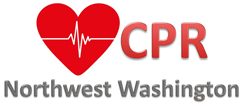Here at CPR Northwest Washington, for Healthcare Provider BLS training we focus on lots of practice of the critical aspects of high quality CPR, starting with high quality compressions.
BLS Single Rescuer Important Aspects include:
- BLS rescuers are encouraged to simultaneously perform some steps like, checking for breathing
and pulse at the same time. This is important because it can limit interruptions from compressions and reduce the time to first chest compression.
- In the same way a healthcare provider that is part of an integrated team of highly trained rescuers may use a choreographed approach that accomplishes multiple steps. This allows for assessments simultaneously performed, rather than the sequential manner used by individual rescuers as with a lay provider/rescuer. For example, one rescuer activates the emergency response system, while another begins chest compressions, a third either provides ventilation or retrieves the bag-mask device for rescue breaths, and a fourth retrieves and sets up a manueal defibrillator or an AED.
- Here at CPR Northwest Washington, a strong focus has been placed on high-quality CPR using performance targets. Things like compressions of adequate rate and depth, allowing complete chest recoil between compressions, minimizing interruptions in compressions, and avoiding excessive ventilation. See Table 1.
- For 2015 and beyond, the AHA compression rate is modified to a range of 100 to 120/min.
- For 2015 and beyond, compression depth for adults is modified to at least 2 inches (5 cm) but should not exceed 2.4 inches (6 cm).
- It is also important to allow full chest wall recoil after each compression and rescuers must avoid leaning on the chest between compressions, which allows the heart to refill with blood for the next compression and output.
Mobile Technologies for BLS
There is also now an increased focus on the use of mobile technologies by bystanders, in other words, you cell phone now plays an important role. This aids in calling 911 sooner and receiving dispatch-assisted CPR instructions. Mobile technology and social media applications that notify rescuers of a nearby cardiac arrest are important because the use of modern mobile technology, (cell phones) may increase the rate of bystander-initiated CPR. Bystanders should use mobile phones to immediately call 911. They can place the phones on speaker so the dispatcher can help bystanders check for breathing, get the precise location for compressions and provide instructions for performing high quality CPR.
For Healthcare Provider BLS certification classes offered here at CPR Northwest Washington, check out Healthcare Provider BLS page.




